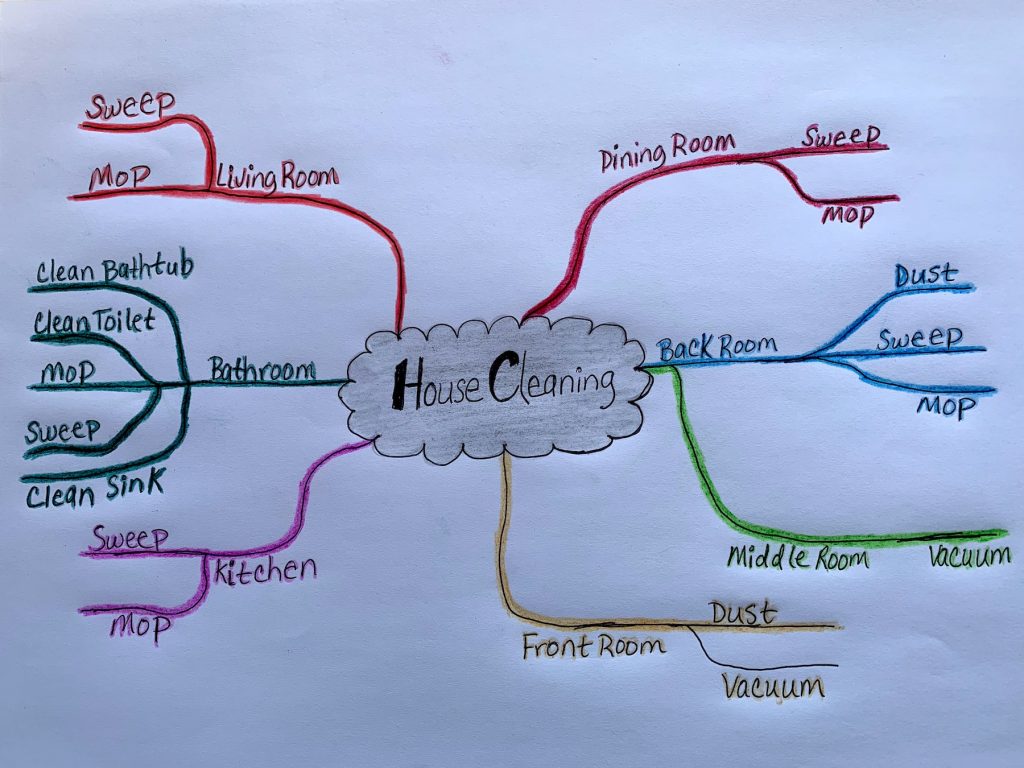Welcome to mind mapping. Mind mapping is Plan To Do (PTD) and PTD is mind mapping. This is where you begin (plan) before you can actually do.
When looking at a mind map, you will see how similar it looks to a street map or map of a city. This is a wonderful picture of a mind map because you are using it to navigate your way through your project, task or to-do list.
How Are Mind Maps Structured?
Like the majority of mind maps, it starts at the center of the city (continuing with the city map analogy). It represents the main idea of your mind map. If it’s a to-do list, then you can write, “To-Do List.” If it’s a project then you can write the project’s name.
Next, from the center of that city, you will have several different roads leading from it. These roads are what’s called your areas of focus. For example, let’s say you have an unorganized or unstructured to-do list of items that spans different locations (i.e. work, school, home, etc.). These would be your areas of focus.
Now, from each of those roads (areas of focus) you will start to branch off into other roads or secondary roads. These are actionable things or your to-do list items broken down into their appropriate area of focus. So under work, you would branch out and write out the appropriate to-do items and the same goes for school, home and so forth.
To help you better understand, let’s take a look at an example:
The picture above is a mind map of a house cleaning project. If you get overwhelmed with house cleaning and don’t know where to start, then this is a perfect example for you.
As you can see there are seven focus areas: dining room, back room, middle room, front room, kitchen, bathroom and living room. Before going on, make note that only keywords or short key phrases are used. This is the best practice for mind mapping, but feel free to do what works for you.
Next, moving beyond each focus area are actions that need to be done in each of those areas. (Please note that this is an example of a to-do list type mind map. Therefore, secondary roads are not always action items.) Now that you have a birds eye view of your house cleaning project, you can now determine how to tackle it.
By studying this mind map, there are four of ways you could tackle this project.
#1 Tackle Like Actions First
In the mind map, you can see that several rooms have actions that are similar. Five rooms need sweeping & mopping, two rooms need dusting and two rooms need vacuuming. You could start off by sweeping then mopping the five rooms, then tackle the rooms that need vacuuming, then dusting and then the remaining items for the bathroom. Also, you would want to start with mopping the bathroom after sweeping, so that by the time you go back to it, the floor will be dry.
#2 Move Clockwise
The second way you could tackle this project is by moving clockwise through the mind map. You could move clockwise throughout the day or move clockwise throughout the week.
#3 Time Blocking
The third way you could tackle this project is by using time blocking. Time blocking is scheduling your tasks into time slots in a weekly planner or calendar.
How it works is that you would create a to-do list from your mind map. If you wanted to tackle them in one day, then you would schedule your tasks into 30 minute increments or more with 10 to 15 minute breaks in between. An alternative is you could spread them throughout the week giving them appropriate time slots.
#4 Structured Checklist
The fourth way you could tackle this project is by creating a structured checklist. If you are a creative professional, then this would likely be the best option for you. Without the stress of a set time constraint, a creative can move step by step through it, realizing that it may take 15 minutes or 2 hours.
By mapping out your project, task or to-do list, you get a better picture of what needs to get done, and it gives you a better vantage point in order to figure out how you want to tackle it. You also have the freedom to choose how you want to structure it or you can integrate it into your current work flow.
Well, that’s PTD in a nutshell. It is simple, minimalistic, flexible and easy to follow. Make sure to check out the rest of the articles for other mind map examples as well as other helpful articles to help you plan to do.
Have questions? Check out the forums.
